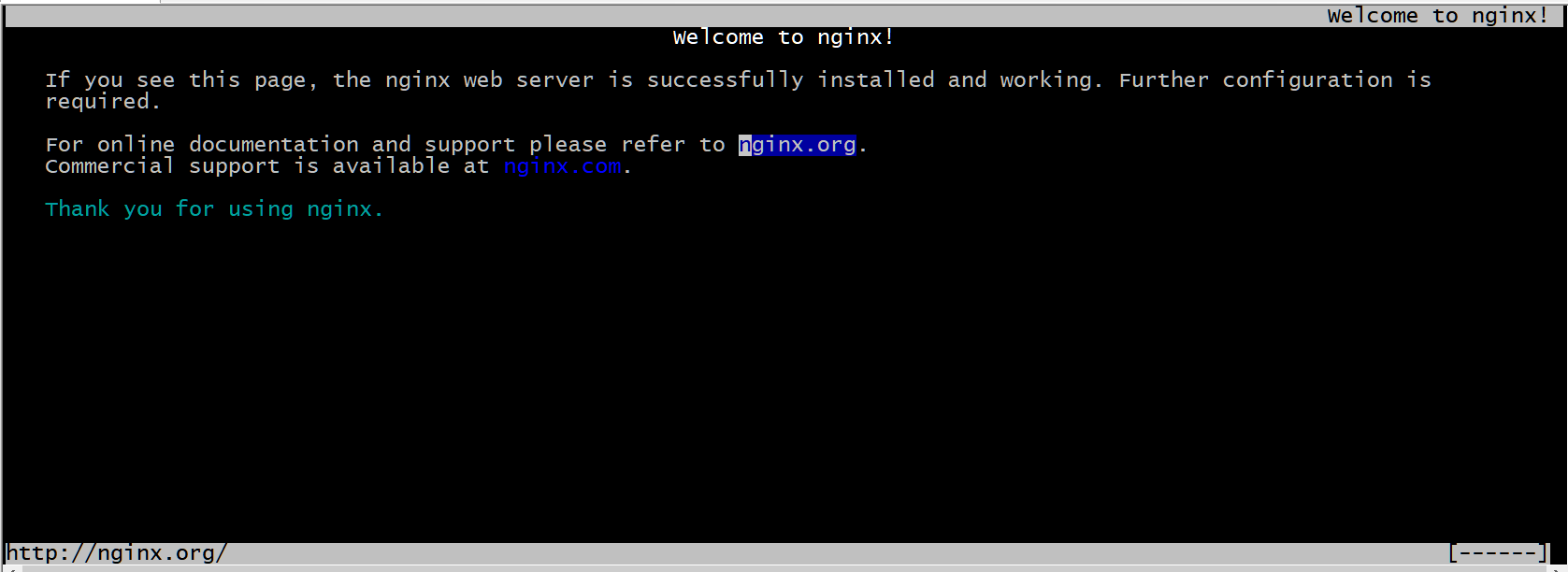nginx可以使用yum也可以使用源码包安装,下面以源码包安装为例。
tar -xzvf nginx-1.21.0.tar.gz
cd nginx-1.21.0
./configure --help
./configure --prefix=/usr/local/nginx #指定安装路径
我的环境在安装过程中遇到./configure: error: the HTTP gzip module requires the zlib library.问题
yum search zlib搜索依赖包,然后yum install 安装依赖包。
make
make install 如果整个过程没有报错即安装完成
启动前检查nginx默认监听端口80是否被占用
netstat -atlnp|grep :80 或者 lsof -i :80
启动nginx
/usr/local/nginx/sbin/nginx
验证nginx是否启动成功
netstat -atlnp|grep :80 或者 lsof -i :80
登录网页验证nginx是否成功,为了避免windows浏览器缓存对后续实验的影响登录使用elinks在linux进行验证
elinks http://nginxserverip 有下面显示说明nginx安装成功了

nginx默认配置文件中#注释的配置并不是不使用的配置项,而是该配置项默认就是注释行的值
#nginx工作进程使用哪个用户启动,默认使用nobody用户
#user nobody;
#nginx工作进程的启动数量,一般和服务器cpu数量配置一致
worker_processes 1;
#全局错误日志的位置及日志格式
#error_log logs/error.log;
#error_log logs/error.log notice;
#error_log logs/error.log info;
#pid文件位置
#pid logs/nginx.pid;
events {
#每个工作进程支持的最大的并发数,线程数。
worker_connections 1024;
}
#http服务器设置
http {
#设定mime类型,类型由mime.type文件定义,通常不做修改
include mime.types;
default_type application/octet-stream;
#访问日志格式 此日志格式的名称 日志格式的具体定义
#log_format main ‘$remote_addr - $remote_user [$time_local] "$request" ‘
# ‘$status $body_bytes_sent "$http_referer" ‘
# ‘"$http_user_agent" "$http_x_forwarded_for"‘;
#$remote_addr与$http_x_forwarded_for用以记录客户端的ip
#$remote_user客户端名称
#$time_local访问时间与时区
#$request请求的url和协议
#$status请求的状态
#$body_bytes_sent发送给客户端文件的大小
#$http_referer从哪个页面连接访问过来的
#$http_user_agent用户浏览器的信息
log_format test ‘"[test_log]"_$remote_addr - $remote_user [$time_local] "$request" ‘
‘$status $body_bytes_sent "$http_referer" ‘;
#全局访问日志的路径以及使用哪种日志格式
#access_log logs/access.log main;
#零拷贝模式来输出文件,对于普通应用,必须设置为on
sendfile on;
#允许或者禁止socket的TCP_CORK选项,在sendfile打开时一并打开,默认状态打开
#tcp_nopush on;
#长链接超时时间
#keepalive_timeout 0;
keepalive_timeout 65;
#开启压缩,默认打开。可以降低服务器带宽
#gzip on;
#虚拟主机
server {
#虚拟机主机监听的端口
listen 80;
#虚拟主机的域名
server_name localhost;
#虚拟主机使用的字符集
#charset koi8-r;
#该server使用的访问日志存储路径以及使用哪种日志格式
access_log logs/test.access.log test;
#定义web根路径
location / {
#使用nginx下的html作为web的根路径
root html;
#索引页
index index.html index.htm;
}
location /a {
allow 182.168.0.0/16;
allow 127.0.0.1;
#return https://www.baidu.com;
deny all;
#return 502;
##触发deny默认返回403,也可以指定本机其它html或者超链接
#return https://www.jd.com;
}
location /b {
#auth banner
auth_basic "login auth test";
#username passwd file
auth_basic_user_file /etc/my_nginx/htpasswd;
}
#error_page 404 /404.html;
# redirect server error pages to the static page /50x.html
#根据错误码返回对应的错误页
error_page 500 502 503 504 /50x.html;
#定义/50x.html页面的路径
location = /50x.html {
root html;
}
# proxy the PHP scripts to Apache listening on 127.0.0.1:80
#
#location ~ \.php$ {
# proxy_pass http://127.0.0.1;
#}
# pass the PHP scripts to FastCGI server listening on 127.0.0.1:9000
#
#location ~ \.php$ {
# root html;
# fastcgi_pass 127.0.0.1:9000;
# fastcgi_index index.php;
# fastcgi_param SCRIPT_FILENAME /scripts$fastcgi_script_name;
# include fastcgi_params;
#}
# deny access to .htaccess files, if Apache‘s document root
# concurs with nginx‘s one
#
#location ~ /\.ht {
# deny all;
#}
}
# another virtual host using mix of IP-, name-, and port-based configuration
#
#server {
# listen 8000;
# listen somename:8080;
# server_name somename alias another.alias;
# location / {
# root html;
# index index.html index.htm;
# }
#}
# HTTPS server
#
#server {
# listen 443 ssl;
# server_name localhost;
# ssl_certificate cert.pem;
# ssl_certificate_key cert.key;
# ssl_session_cache shared:SSL:1m;
# ssl_session_timeout 5m;
# ssl_ciphers HIGH:!aNULL:!MD5;
# ssl_prefer_server_ciphers on;
# location / {
# root html;
# index index.html index.htm;
# }
#}
}
原文:https://www.cnblogs.com/flags-blog/p/14897849.html